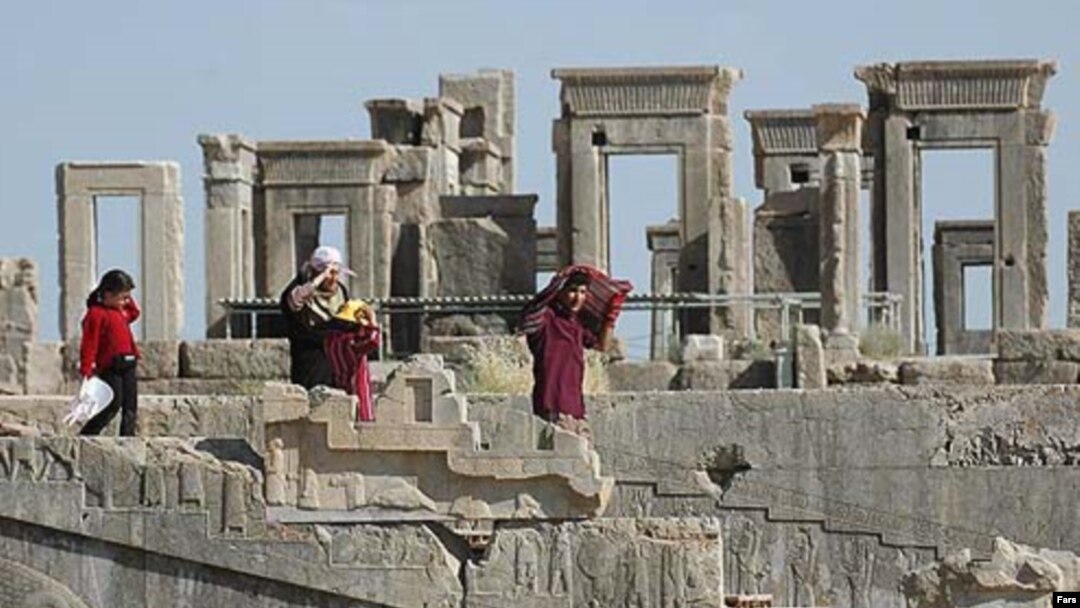The dam is being constructed in the Bolaghi Valley of the southern Fars Province, where archeologists have in the past three years identified more than 100 potentially important historical sites.
Threatened By Water?
Activists have warned that the dam could be a real threat to Iran's historical sites once its reservoir is filled with water, which is due to happen within five months -- inundating parts of the valley where the historical sites are located.
Some activists warned that filling the dam would also lead to the flooding of Pasargadae, and some have even compared the project to the destruction of the giant Bamiyan Buddhas by the Taliban.
Maziar Kazemi is the director of the Takht-e Jamshid (Persepolis) historical site affiliated to Iran's Cultural Heritage Organization. He tells RFE/RL that UNESCO's world heritage site of Pasargadae is not endangered by the dam because the ruins of the former capital are at a higher altitude.
"The level of the water will reach an altitude 1,830 meters at its peak but the height of the Pasargadae historical region is 1,850 meters above the sea level," he said. "At the peak of its inundation the distance between the dam's lake and Pasargadae would be 9 kilometers; that means that the Sivand Dam is by no means a threat to the Pasargadae region."
State Says No Danger
It is, however, unclear if the increased moisture caused by the dam will affect the archeological site at Pasargadae, which represents a great example of ancient Iranian civilization. Kazemi says research is being conducted about the possible impact of humidity.
"This dam was supposed to be completed along with the Dorudzand and Molasadra dams," he said. "Dorudzand Dam is currently being operated; in the 27-28 years since its launch we have not witnessed any signs that the increase in the region's humidity has lead to the destruction of the environment around it. Regarding Pasargadae, at the time of its construction [some 3,000 years ago], the Polvar River ran nearby and this river was used to irrigate Pasargadae's gardens that were known as pardis [Persian for paradise]."
The project and its potential threat to Pasargadae, which includes the mausoleum of Cyrus the Great, has led to an outcry among many Iranians who consider the site an important part of their national heritage.
Cyrus the Great -- the founder of the Persian Empire in the sixth century B.C. -- is known for issuing what is described as the first declaration of human rights.
Prominent lawyer Mohammad Ali Dadkhah says his legacy should be valued and given high priority.
Development Versus Historical Legacy
"A single development project that would be effective for a maximum of 50 years should not destroy a 3,000-year-old culture," he said. "A broken rock from Cyrus's tomb has more value than the whole Sivand Dam because a dam can be built anywhere in this country but in the whole world we have only one Cyrus mausoleum."
Others have said that Iran's leaders should give a higher value to the country's ancient sites and maintain a balance between safeguarding historical heritage and economic development.
Iranian official Kazemi defends the Sivand Dam as a "very good move" that will improve the life of people in the region.
"Unfortunately, a lack of coordination between the Energy Ministry and the Cultural Heritage Organization in the past 10 or 12 years since the study of the project began has created this issue," Kazemi said. "But regarding the scarcity of water in the region we can say that it will transform the life of the people in the region and also people living in the town of Arsanjan in Fars."
But he does acknowledge that recently discovered archaeological sites about which not much is known will go under water once the dam is filled.
"About 80 percent of the 130 historical sites that have been identified in the Bolaghi Valley will be underwater after the flooding of the Sivand Dam," he continued. "In these sites, [significant] historical remains like Persepolis have not been found. These are research and study sites, maybe the information that is being is extracted would show they don't include any unique remains, meaning that the extraction and study of their information would be enough for experts."
A Race Against Time
In 2003, the United Nations issued an appeal for archaeologists to rush to the Bolaghi Valley to unearth and record the historical remains before the dam was filled.
Since then historical remains -- including long canals built in stone, caves inhabited some 4,000 years ago, metal furnaces, and ancient cemeteries -- have been excavated by Iranian and international archaeologists.
While some Iranian officials have downplayed the importance of these sites, activists and archaeologists have called for more time to be given to rescue the historical remains. They say the sites hold a wealth of information about Iran's past.
Among those concerned by the project is Iran's former empress, Shabanou Farah Pahlavi, who spoke to Radio Farda.
"I hope and I'm sure that people in Iran who care about their culture and civilization will do their best so that archaeologists can complete the excavation before the filling of the dam," she said. "I would like to say that governments come and go, people come and go, but it's the culture and the cultural identity of a nation that should remain."
Officials have said that the filling of the Sivand Dam was postponed for a year because of the importance of the region's historic heritage. They say that due to its economic importance, the dam was at first to be finished in the shortest time possible.
That leaves only a few months for archaeologists to complete their salvaging of the historical sites there and for them to record what they can before water will destroy the historical remains or make them inaccessible.
(Radio Farda's Jean Khakzad interviewed Farah Pahlavi.)
Ancient Persepolis
A gallery of images about one of Iran's most spectacular archeological sites.


